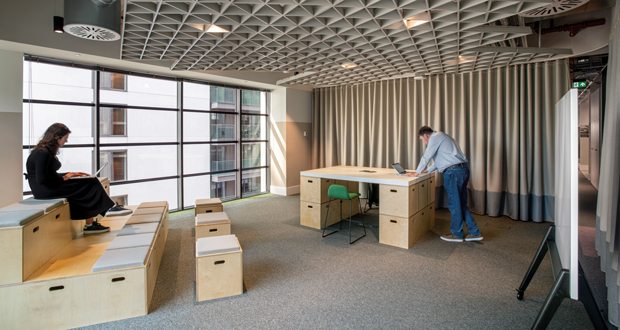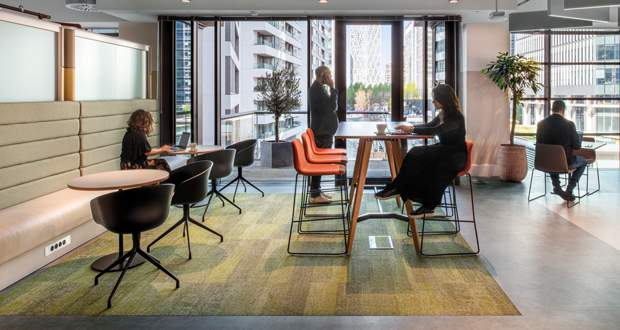Andrew Jackson, Business Development Director EMEA, Shaw Contract on procuring flooring products and materials that contribute to a Circular Economy approach.
If we are to limit global warming to no more than 1.5 degrees Celsius in accordance with the Paris Agreement, reducing embodied carbon is imperative. For built environment specialists, that means ensuring that buildings embrace sustainable processes and practices.
While the need to rethink how we approach both the build and fit-out of each category of our commercial buildings to meet targets around climate change is acknowledged within the industry as a whole, how this change happens is not as clear cut. While Government and regulation drivers play a large part, they are fundamentally one part of a giant jigsaw.
There is change happening. CBRE Research’s Global Report (October 2021) ESG & Real Estate: Top 10 Things Investors Need to Know highlighted that many investors are formally including carbon neutrality objectives in new investment strategies, and that energy-saving/net zero goals are the new normal. Another core trend was ‘green leases’ between landlords and tenants to meet certain environmental objectives will become a more common tool for investors to monitor and drive the environmental performance of their real estate assets.
Shifting to renewable energy, putting a price on carbon, and phasing out coal are all elements in reducing carbon emissions. But ultimately stronger and broader emission-reduction targets are necessary for the preservation of long-term human and environmental health.
Cradle to Cradle
Promoting the use of renewable energy and reducing carbon emissions are two of the five pillars in the Cradle to Cradle philosophy.
In fact, through the Cradle to Cradle Certified Products Program, the safety, circularity and responsibility of materials and products are assessed across five categories of sustainability performance:
- Material health: ensuring materials are safe for humans and the environment;
- Product circularity: enabling a circular economy through regenerative products and process design;
- Clean air and climate protection: protecting clean air, promoting renewable energy, and reducing harmful emissions;
- Water and soil stewardship: safeguarding clean water and healthy soils; and
- Social fairness: respecting human rights and contributing to a fair and equitable society.
Cradle to Cradle is a concept that has been embraced by many operating in the built environment seeking to adopt best practices that enable the potentially limitless circulation of materials. We are proud that Shaw Contract has been actively engaged in Cradle to Cradle design for more than 20 years, introducing the first Cradle to Cradle Certified flooring product in 1999.
A Cradle to Cradle approach embraces the principal that instead of raw materials being disposed of at the end of a product’s lifecycle, all resources should reused indefinitely. It also focuses on material ingredients in relation to Health and Wellbeing in interior spaces and supports the Circular Economy.

The Circular Economy approach represents a regenerative, closed-loop strategy to sustainability. We supported some new industry research over the past year looking at net zero and what sustainability means, through the critical lens of enabling a move to a Circular Economy.
The first phase of this research undertaken by Insight Futures looked at ‘How might we derisk the move to a circular economy for the built environment, in Scotland?’ with a range of stakeholders across the built environment. As a follow-up, in a second survey Insight Futures spoke to a similar group of stakeholders in England and Wales.
A key objective was to identify the motivations and barriers for the adoption of circular business models including how to create, deliver and capture value to companies. The research also looked to explore the state of industry readiness, in light of any future policy, regulation and taxation changes.
Our focus on the Circular Economy forms one of our four points of ambition that company-wide is our sustainability focus called People Together, Planet Forever. The other points of ambition are reducing Carbon Impact; Material Health; and Diversity, Equity and Inclusion. Together they form what we consider a holistic way of looking at how we as a business can support the preservation of long-term human and environmental health.
Survey results
In each of the two surveys, the respondents included construction firms, professional services firms, main contractors, designers, representatives of public bodies and developers.
Of real interest are some of the correlations between the two surveys and what they both tell us about an appetite for change.
In terms of a commitment, 80 per cent of respondents cited that the Circular Economy was part of their organisation’s strategy. All respondents saw the need for change (100 per cent in England/Wales and 99 per cent in Scotland).
However, over 60 per cent in both England/Wales and Scotland said that the benefits of a Circular Economy approach were not well communicated and understood.
Another barrier was cited by over 60 per cent in England/Wales, and again a similar percentage in Scotland, was the fact that clients and others value engineer out circular aspirations for sustainable projects.
Clear themes from both surveys from Insight Futures concluded were:
- A significant gap in terms of training and support, amongst the different stakeholders.
- A lack of knowledge and understanding of the internal benefits of circular economy and why it’s worth the time, cost and capacity away from business as usual to drive it forward.
- The need for integrated knowledge and learning is important for the sector to move forward collaboratively.
- A better understanding of the number of initiatives taking place in relation to the construction industry that focus on training; central data gathering, analysis and use; and supply chain optimisation – all of which provide an opportunity for organisations to take part.
Where next?
In the England/Wales survey 96 per cent agreed in some capacity that procurement teams are slow/resistant to change. In today’s media-hyped world, it would seem one answer is a need for practical, easy-to-understand cost-efficient solutions as a way of meeting the challenge and overcoming some resistance. Or is the need more to be able to attribute real value to the Circular Economy approach? The answer is likely to be both.
Collectively, we need to look at some innovative approaches to make this a reality. UK firm IOBAC UK Ltd’s MagTabs offer a new option for installing flooring products that contributes to a shift to a Circular Economy approach. It offers a solution for a wide variety of floor coverings to be installed adhesive free to raised metal access floors and IOBAC’s magnetically receptive range of underlays and resins.
Adhesive-free installation represents a different way of thinking about flooring installation – moving it from single-use to a flexible design element that can be reused and repurposed several times before being recycled. This also gives flooring adaptability to today’s flexible space requirements, whether that’s rental properties, flexible work environments or pop-up retail spaces.
A main aim of the Circular Economy is to design waste out of the economic system. This requires a mindset shift from thinking of end-of-life products as discardable ‘trash’ to instead being a valuable source of materials.

We see it as our duty to act on these issues now.
Looking at sustainable construction specifically, there is still a long way to go. Yet if we are to meet net zero, we must change. Across the built environment, all parties need to fundamentally play their part, taking more proactive steps to limit their carbon impact.
If we are to turn talk into action, then we all need to make the changes that we want to see. Continued collaboration and communication across the whole supply chain and with developers, end users and building occupiers is key.
For copies of either of the Reports from the ‘How might we’ surveys, please email infouk@shawcontract.com





